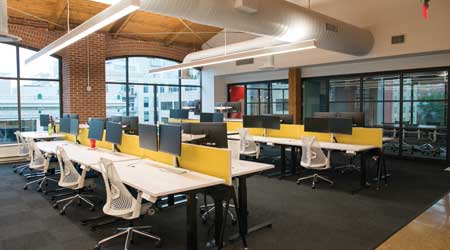 Networked lighting controls support quality lighting by tuning light level, brightness, and color output.
Networked lighting controls support quality lighting by tuning light level, brightness, and color output.Networked Lighting Controls Offer Benefits Beyond Energy Efficiency
Failing to install lighting controls during an LED upgrade is a major missed opportunity. Here's how to take advantage of all the benefits of lighting controls.
Building owners and facility managers across the United States are replacing traditional lighting with energy-efficient, long-lasting LED lighting that can produce up to 50 percent energy cost savings while maintaining or improving lighting quality. The most attractive investments are in applications with high energy or maintenance costs or long operating hours, or where utility rebates are available.
In past retrofit booms fueled by technological shifts in the lighting industry, automatic lighting controls generally found limited application in existing buildings, despite substantial rebates. These are devices that turn off lighting or reduce light output when it is not needed so as to slash energy waste. Though a lighting upgrade is the ideal time to incorporate lighting controls, often the economics proved challenging due to the cost of installing new wiring. As a result, controls were often limited to wallbox occupancy sensors and similar upgrades.
Failing to install lighting controls as part of an LED upgrade is a major missed opportunity, however. Advances in wireless control mean no hardwiring is required, and control hardware is increasingly being integrated with luminaires. LEDs are easily controlled, do not suffer a penalty in efficiency when dimmed even at low light levels, pose a negligible reduction in light source life due to frequent switching such as when used with occupancy sensors, and may extend service life if dimming is deployed. The majority of LED products are dimmable out of the box or as a standard option with a negligible cost premium, providing unprecedented potential for flexibility. Besides changing intensity, dimming can be used to dynamically change the shade of white light to support different visual needs. What’s more, as digital devices, LEDs are inherently compatible with digital lighting controls that feature onboard lighting intelligence and enable data sharing.
Alongside the LED revolution, another major technological shift is occurring in the lighting industry, centered around networked lighting controls. These remarkable intelligent control systems offer the ability to layer control strategies for maximum energy savings, programmable operation, wireless connectivity across a space or building or with other building systems, software-based control zoning and rezoning, and valuable measuring and monitoring. With their processing power, bandwidth, connectivity, and ability to install additional sensors in new LED luminaires, they offer a platform for a Building Internet of Things (B-IoT) solution.
According to a 2017 report by the DesignLights Consortium based on measuring energy savings at more than 100 applications, networked lighting controls produced average lighting energy savings of 47 percent. Due to this significant potential, a growing number of utility rebate programs are offering significant rebates specifically supporting networked controls, with the majority positioning the incentive as a rebate bonus for installing an LED luminaire.
While energy savings provide the most easily calculable return, the biggest value in networked controls may not have much to do with energy at all but instead may be found in their non-energy benefits.
Related Topics:














